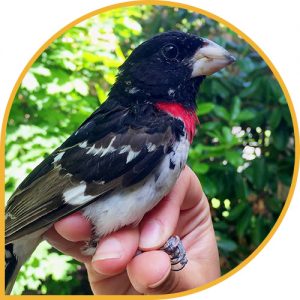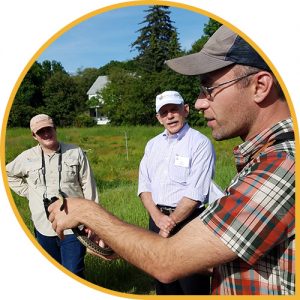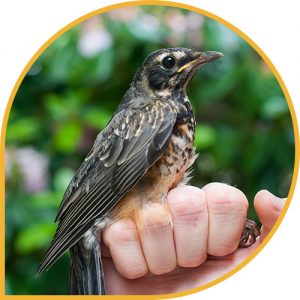The last week of the 2019 spring banding season is complete! During this final week, we banded 32 new birds and processed 54 repeats. Our final spring totals are 1,331 new birds banded and 797 repeats processed, resulting in 2,128 total birds handled. We ended up with 77 species for the season, with our last new species for the spring being a female Yellow-shafted Flicker; a bird we’ve heard and seen around the property but somehow had evaded our nets until now. Interestingly, we also caught a second-year male Rose-breasted Grosbeak this week that was in breeding condition along the bluff nets. We usually don’t catch this species since they frequent the higher canopy of trees.

Signs of summer are all around with baby birds emerging from their nests and our catching several more hatch-year birds this week including Hairy Woodpecker, Mourning Dove, and a speckled American Robin still in its juvenile plumage. On our front lawn, two other hatch-year robins followed a parent around, begging for food. One of them attempted to beg from an uninterested Gray Catbird. Excitingly, down in the “Bennett Bog,” Alan Kneidel, Staff Biologist, spotted a female Mallard and her ducklings! We believe she nested on the edge of the bog since we frequently saw a Mallard pair feeding there throughout the spring.
In a season characterized by rain and wind, our last week was no exception. Tuesday had heavy rains all morning and afternoon until a cold front moved through and skies cleared. On Thursday, a stunning red sunrise graced the horizon. As we opened nets, the eerie, moaning “song” of Gray Seals rose from the water and echoed through the woods. Just an hour later, the wind had picked up and it began to rain as a large storm system moved through the northeast.

We’d like to thank everyone who stopped by the banding lab on Wednesday during the Annual Meeting & Chairman’s Reception. We hope you enjoyed getting a closer look at the lab and getting to know our team this season. We also hope many of you got to learn more about Manomet’s work to revitalize the Holmes Farm property for better habitat and broader outreach and engagement opportunities in the future.

Those who joined Alan and Evan Dalton, Lead Instructor of Landbird Conservation, on a brief tour of the property were treated to a variety of wildlife, including a flurry of monarch butterflies making use of the abundance of milkweed coming up on the farm. For an extensive list of wildlife recorded at Manomet’s headquarters, visit our iNaturalist page and browse the more than 900 species of plants and animals spotted by staff, interns, and visitors.
Looking back on the spring season, we remember some of our favorite moments in the lab. In April, we banded two Summer Tanagers, a result of a strong storm system that caused an overshoot of some migrants as they moved north. The nearest breeding Summer Tanagers are hundreds of miles to the south, so catching two second-year males in the same day within hours of each other was amazing! Of the 57 American Redstarts that we caught, eight were after-second-year (ASY) males with bright orange and inky black plumage. We normally only catch one to four ASY Redstarts in a season, so this was certainly memorable. We also banded above average numbers of Blue-headed Vireo (18), Swainson’s Thrush (57), Gray-cheeked Thrush (3), Yellow-bellied Flycatcher (27), and Alder Flycatcher (52). Trevor-Lloyd Evans dove into past data and found that we had banded the most Swainson’s Thrushes in the spring since 1992, 26 years!

We had two major pushes in migration this spring. Our first happened on International Migratory Bird Day on May 11th, which was comprised mainly of Gray Catbirds and Black-and-white Warblers. Our second was an incredible push of Empidonax flycatchers and Swainson’s Thrushes in late May. For two days, almost everyone had a flycatcher in the hand and was deftly taking measurements to find out what species it was before banding. Adding it up through the season, we banded a total of 134 Empidonax flycatchers, the majority of them between the 30th and 31st of May. Our most frequently captured bird was, of course, the Gray Catbird, at 278 new birds banded.

Returning birds are often one of the most interesting mysteries to puzzle out. Throughout the season, we have birds returning to breed in the high-quality habitats that Manomet and the Holmes Farm offer. We had 121 recaptures this spring that were first banded in a previous season. Some of these birds included a one-year-old Ovenbird, a five-year-old White-throated Sparrow, a seven-year-old Gray Catbird and our oldest bird, a 10-year-old Northern Cardinal.
Another important part of the banding season is educational groups. Over the season, we had 10 educational groups of nearly 300 people that visited Manomet to see the banding operation and get an up-close look at birds in the hand. It’s also an opportunity to show them Manomet’s grounds and the diverse habitats and species that inhabit them.
For now, the nets are packed away and the plants will overgrow the net lanes until August when the trimmers come out and the nets are raised again for the southward journey in the fall!
Cheers,
Megan, Sarah, Evan, and Jeremy





 Back to all
Back to all
